Cetaceans and seabirds
Cetaceans and seabirds
When you’re out at sea on a whale watching tour, the best thing to do is to always be on the lookout for whales – the more eyes we have around the boat, the better our chances of spotting something!
Of course, it helps to know what you’re looking for. Whales and dolphins are marine mammals, so although they live their whole lives in the sea, they do have to come up for air. When they are at the surface is when we have a chance of seeing them: keep an eye out for the back and dorsal fin cutting through the water. If you’re lucky, you may see a breach – this is when cetaceans throw their whole bodies out of the water, which makes them difficult to miss!
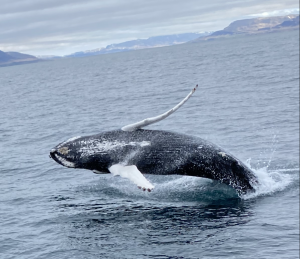
A humpback whale breaching. Photo from Special Tours.
But remember, it’s not just the cetaceans themselves you should keep an eye out for. There are other important cues that can help when searching for whales at sea. The first of these is the blow – the puff of air as a whale exhales after coming back to the surface to breathe. This is especially important for larger whales, as their blow may be seen from several kilometers away!
Seabirds are a particularly important cue for us – especially if they are feeding. Seabirds are often easier to spot as they are mostly airborne, while cetaceans are almost always in the water. This makes cetaceans much harder to spot, as they may either be completely submerged, or obscured by poor weather conditions such as waves and swell.
Certain interactions between seabirds and cetaceans are well known, both anecdotally and in research carried out by biologists. Cetaceans and seabirds can have a very similar diet, and they are often seen feeding in the same area on the same prey. It is thought that cetaceans make prey easier to catch for seabirds by forcing it closer to the surface, within diving depth, or by herding it into large, dense aggregations. However, it is also possible that feeding seabirds could alert nearby cetaceans to a prey patch, or that they can take advantage of the hunting behaviour of seabirds.
In this blog post, we will introduce to you some of the species of seabirds you might spot on your whale watching tour, and which cetaceans they might be hanging out with.
Auks
This family of birds contains puffins, guillemots, and razorbills. Auks are amazing at swimming, but not so great at flying! They can dive to considerable depths while hunting – common guillemots, for example, have been recorded going as deep as 180m.
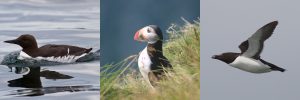
The top three auks in Iceland: common guillemot, Atlantic puffin, and razorbill. Common guillemot and razorbill from Natural England.
About 60% of all the Atlantic puffins in the world breed in Iceland, so they are very common here in summertime. They make a great subject for photographers, with their brightly coloured beak and legs.
If you see auks, keep an eye out for:
- Minke whales (guillemots and puffins)
- Humpback whales (puffins)
- Harbour porpoises (all auks)
Gannets
Few seabirds are as easy to identify as the gannet. They have a white body, yellowish head, and black wingtips, and are larger than most gulls. However, the most distinctive thing about them by far is how they hunt: by folding their wings and plunging into the water from a height, snatching fish at high speeds.
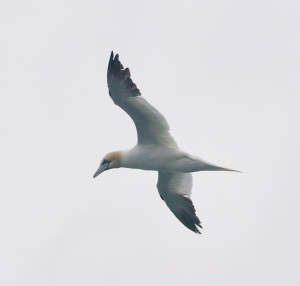
A gannet searching for its prey.
Research into the hunting behaviour of gannets off the coast of South Africa found that they seem to spend more searching for dolphins or other gannets than they spend looking for their prey itself. Once one gannet finds a patch of food, others quickly join the feeding frenzy – with so many gannets diving into the water, these feeding aggregations are visible from quite some distance.
If you see gannets, keep an eye out for:
- Minke whales
- White-beaked dolphins
Gannets are known to feed alongside almost every species of cetacean in the North Atlantic, but interactions are most commonly reported with these two species.
Shearwaters
Manx Shearwaters are a very small species of seabird. Their main breeding colony is in Vestmannaeyjar and they can be seen all along the southwest coast of Iceland. There are two other species of shearwater which could be spotted in Iceland: the great shearwater and the sooty shearwater, both of which breed in the southern hemisphere and migrate to the northern hemisphere for the boreal summer.
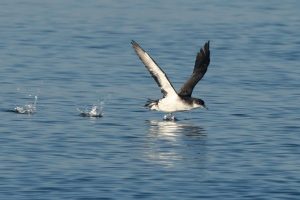
A Manx shearwater taking off from the sea surface. Photo from Electronic collection of Georgia birds.
Manx shearwaters often sit in large groups on the water’s surface – a behaviour called rafting. Some rafts can be as large as several thousand birds!
If you see shearwaters, keep an eye out for:
- Minke whales
Kittiwakes
Kittiwakes are small gulls – they look similar to other types of gull, such as the herring and common gulls, but can be distinguished by their black legs and feet. They breed in colonies on cliffs which can be heard before they are seen! Kittiwakes are very noisy birds. In fact, they are named after the noise they make: a screech that sounds as if they are saying ‘kittiwake’.
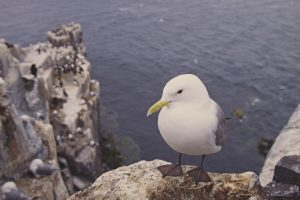
A kittiwake on the cliff of its breeding colony. Photo from Natural England.
If you see kittiwakes, keep an eye out for:
- Minke whales
- Humpback whales
- Harbour porpoises
Other species
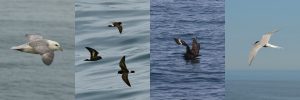
Some other birds to keep an eye out for: northern fulmar, European storm petrel, great skua, and Arctic tern. Storm petrels from The Crossley ID Guide Eastern Birds, Arctic tern from Eric Sonstroem.
- Fulmars, storm petrels, skuas and Arctic terns have all been observed feeding alongside minke whales – but these interactions are not so common as those mentioned above
- Arctic terns and skuas can also feed in association with harbour porpoises
By Eilidh
Photos by the author unless otherwise credited.








